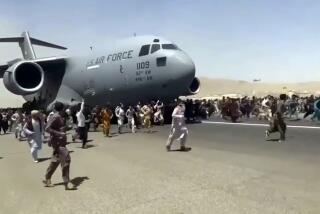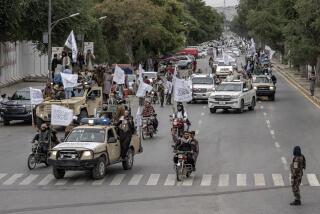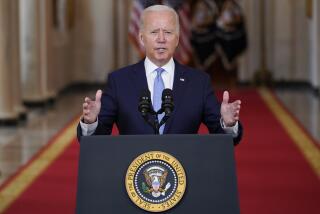War’s wind-down fraught with risk for troops, Afghans

The United States and its allies have been infusing troops, weapons and authority into Afghanistan for more than 11 years to shackle Taliban extremists and uproot Al Qaeda’s bases for waging war against the West. Winding down the mission will be swifter but riddled with risk and complications.
President Obama indicated this week that the withdrawal of 66,000 U.S. troops will be front-loaded, with more than half leaving within the year. Other major troop-contributing nations have already curtailed combat operations and begun their own departures.
But the strategic advances accomplished by the post-9/11 war have been limited and in few instances immune from reversal. As the Pentagon and the North Atlantic Treaty Organization draft plans for the pullout, there is concern that equipment convoys will be vulnerable to insurgent ambush, that Afghanistan’s police and soldiers won’t be ready to protect their own country and that the fragile government and institutions may be unable to withstand assault by extremists bent on once again dividing Afghans by rekindling ethnic, tribal and religious conflicts.
The impending withdrawal isn’t the result of the mission to defeat global terrorism having been accomplished. Rather, Western diplomats and scholars point out, the U.S. decision to leave Afghanistan is driven by Americans’ fatigue with foreign wars and their staggering cost in blood and treasure. And while the incremental structure of the drawdown is intended to allow its architects to refine logistical details as they go, the political imperative to decamp is unlikely to be eroded by the predictable setbacks.
Taliban forces are likely to harass departing U.S. convoys because “they would want to make it look like we’ve been driven out of the country,” said James Dobbins, who was U.S. special envoy to Afghanistan after 9/11 and now heads Rand Corp.’s International Security and Defense Policy Center.
“They may exercise some restraint, so as not to push the United States into re-evaluating whether we should leave,” Dobbins said. “But we can anticipate continued fighting in the contest to control territory, a contest in which Afghan security forces will be the primary combatants.”
Whether the 352,000 Afghan security forces being trained to take over policing and defense will be ready by the end of 2014 remains to be seen, Dobbins said. Much will depend on the number and kind of U.S. forces remaining in the country, a crucial element of the drawdown that has yet to be decided.
Even if the Taliban manages to recover authority in the wake of departing forces, the withdrawal over the next 22 months is likely to carry on as scheduled, Dobbins said, “given the unpopularity of the war and the budget-driven debates we’re having in this country.”
Anthony H. Cordesman, former Pentagon director of intelligence assessment who is now at the Center for Strategic and International Studies, foresees a more difficult withdrawal than the 2009-11 U.S. departure from Iraq.
“Iraq was a lot less complicated because the distances were shorter, you had secure lines of communication and you weren’t dealing with an active threat in most cases,” Cordesman said of the insurgency that had been diluted by a U.S. troop buildup and co-opted by Baghdad political factions.
In Afghanistan, most troops probably will be flown out as bases in stable areas are demobilized. But the masses of equipment -- trucks, tanks, rocket launchers, radar arrays -- will have to traverse hundreds of miles of rutted roads through towering mountains to reach ports in Pakistan or through even more treacherous terrain to the north to send the hardware westward by road or rail from Central Asia.
Cordesman notes that the NATO forces have yet to negotiate an agreement with Pakistan to cross its territory with the voluminous hardware. The Pentagon will also have to work out a schedule to share the limited exit routes with its departing allies, timed to weather, seasonal hostilities and the demands of force protection. In some cases, he said, it may be cheaper to leave equipment for the Afghans and replace it stateside than to bring it home.
More important than the logistics of departure will be a reliable post-2014 U.S. commitment to help Afghanistan strengthen its fragile institutions, said Tom Gouttierre, director of the Center for Afghan Studies at the University of Nebraska at Omaha.
Gouttierre, who has traveled and worked in Afghanistan since 1964, laments that Washington did little to aid Kabul after the Soviet withdrawal in 1989, allowing militants to hijack power and terrorize a war-weary population.
“We dropped them, and that’s when we got the chaos,” Gouttierre said of the U.S. failure to provide the kind of guidance given to Germany, Japan and Korea after World War II.
Obama’s 2009 announcement of benchmarks for completing the Afghan mission marked the first time Washington has fashioned a strategic plan for the country, Gouttierre said.
“Right now our footprint in Afghanistan is much too large,” especially in Kabul, where foreign military and relief works occupy prime real estate and siphon off the country’s most talented workers, Gouttierre said. “It’s good that we are reducing that footprint. Afghans must have a sense that they can confront their challenges and lead toward a solution themselves.”
ALSO:
Oscar Pistorius remains in jail facing murder charge
Mexico finds fire-god figure at top of Pyramid of the Sun
Iranian general reportedly assassinated while traveling from Syria
A foreign correspondent for 25 years, Carol J. Williams traveled to and reported from more than 80 countries in Europe, Asia, the Middle East and Latin America.
More to Read
Start your day right
Sign up for Essential California for news, features and recommendations from the L.A. Times and beyond in your inbox six days a week.
You may occasionally receive promotional content from the Los Angeles Times.







